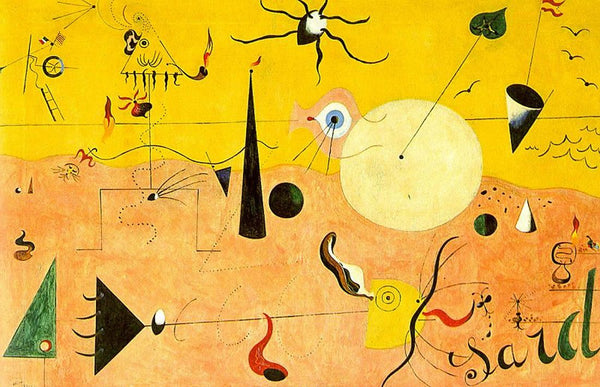Celebrating the solstice

Over the course of an Earth year, as our beautiful blue planet orbits the Sun it wobbles on its axis. Around the 21st June the tilt of the Earth reaches its maximum peak, resulting in the northern hemisphere being the closest possible angle to the life giving star. This is known as the summer solstice. This sun-drenched painting of a 'Catalan landscape' by Joan Miró perfectly captures the sense of heat, light and intrigue that the solstice brings.
During the heady midsummer days, the Sun hangs high up in the sky, seemingly standing still during the midday hours: this is where the term 'solstice' comes from, deriving from the Greek words 'sol', (Sun), and 'sistere', (to make stand).
Understanding, or at least recognising the seasons and the various cycles of nature has always been of paramount importance for our survival. Miró's painting apparently shows a peasant finding his food in a sun-baked land - see it? Me neither but Miró's vision is usefully explained here for those (all?) of us with a more literal view of the world.
Throughout history both winter and summer solstices have been duly noted in the rituals of mankind. For the ancient Greeks the seasons were ushered in by the Horae, the Goddesses of the passing of time, (hence Horae meaning hours), and as the Sun God Apollo reached his midsummer loftiness, the Greeks would celebrate the Summer Solstice with the Kronia festival. This involved celebrating and worshiping the agricultural God, Cronus, and temporarily abandoning the usual strict Greek social code, resulting in slaves making merry and even being served by their masters. The solstice also signalled a one-month countdown to the Olympic games, and was the first day of their classical calendar.
Similarly in ancient Egypt, the summer solstice was also noted as the first day of the year, and heralded the coming of Sirius, the brightest star in the sky, (well, if you exclude the Sun). Sirius was... well, siriusly important to the ancient Egyptians, as they believed its coming was responsible for the annual flooding of the river Nile, which would break its banks and quench the fertile land for their essential crops.
For the Mayans and the Aztecs, although little is known of their social practices during the summer solstice, the exact positioning and designs of some of their surviving temples and public buildings indicate a serious in-depth mathematical understanding of the Sun's seasonal path: resulting in incredibly accurate and striking displays of geometric shadow alignments, as well as brief architectural windows to the Sun.
And so, with another solstice upon us, let us dust off the insect repellent, and raise a glass - or a barbecued morsel - to our very own wonderful star, for it is our time in the Sun!
